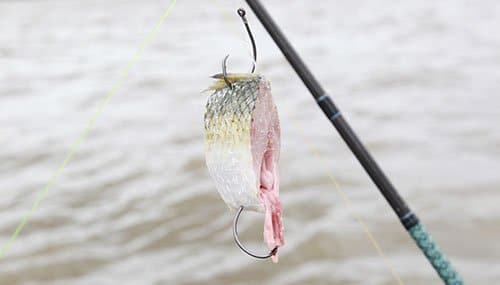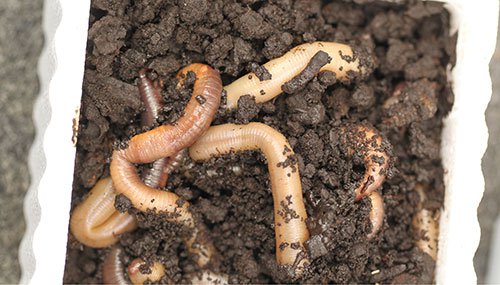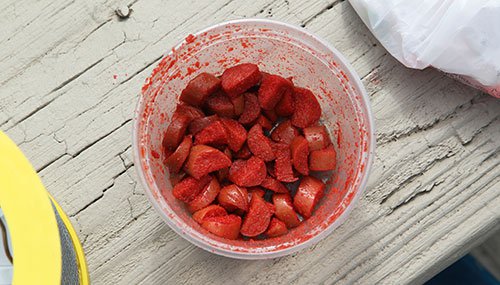Stinky stuff! Catfish baits that reek of success
ON 07-13-2022

July 13, 2022
Randy Zellers
Assistant Chief of Communications
The catfish may be one of the most misunderstood of all Arkansas’s sportfish. It occurs in practically every body of water in the state, grows to gigantic proportions, and is easy to catch with inexpensive equipment. Top off those features with its fantastic flavor, and it’s amazing that anyone would look down on these hardy fish.
The Arkansas Game and Fish Commission stocks thousands of catchable-size channel catfish through its hatchery system each year to small ponds and lakes that cannot keep up with fishing pressure. Mother Nature produces millions more of the fish in Arkansas’s rivers and lakes every year. All it takes to catch them is a little patience and the proper lure to tempt them into biting. The secret ingredient to all good catfish lures is scent.
Catfish can “smell” baits much better than many fish species. Highly sensitive membranes inside the fish’s nostrils detect compounds in the water. The more folds these membranes have, the keener the fish’s sense of smell. Trout have 18 or so of these folds, while largemouth bass may have only 10. The channel catfish is blessed with 140 of these specialized folds to sense smell, enabling it to detect compounds as minute as one part per 100 million.
So what odors make the best bait for catfish? Here are a few tried and true offerings to keep you hooked up this summer.
Smelling Fishy

The best smells of all are going to come from the foods catfish are used to eating. Shad, small bream and chunks of less desirable species like carpsuckers and skipjack are top producers for many catfish anglers.
Justin Homan, lead biologist in the Arkansas Game and Fish Commission’s catfish team, says many veteran catfish anglers, especially those on the big rivers of east Arkansas, favor cut shad and skipjack. These oily fish will put out a scent big catfish are looking for.
“When I’m running jugs with my wife and little girl, we tend to use cut bait as well, especially fish with a tougher skin,” Homan said. “Chunks of carp or buffalo stay on the hook well and will bring in a lot of fish.”
Homan says flathead catfish are much fonder of live baitfish than cut bait, so targeting these big fighters may require a little more effort to care for your lures. Many anglers use goldfish purchased from bait dealers, and he’s personally done well on Lake Conway running trotlines at night with live sunfish.
“You have to catch the sunfish first, and can’t move them from another body of water, but they work very well,” Homan said. “One trick is to check your bait at about midnight. Channel cats may beat the flatheads to your bait, and the flatheads are most active after about midnight. Rebaiting then can really help bring in some bigger cats.”
Any fish or crayfish caught in the wild can’t be transported to another body of water and used as bait there unless it is used as dead bait. The risk of spreading disease or invasive species is too high when moving live, wild-caught baitfish. If you want to use live baitfish but don’t have time to catch them in the body of water where you’ll fish, goldfish, shiners and minnows that can be purchased from bait shops come from baitfish farms that are certified to be free of diseases and other nasties live fish may carry.
Creepy Crawlies

Catalpa worms, nightcrawlers and other crawling critters from the flowerbed also make great bait, and they can be pulled up from the dirt can be transported without issue. Flipping a few bricks from the flowerbed or scraping aside some leaves and digging at the surface of the dirt should garner enough worms for a quick trip. Some anglers have taken the collection of worms to the next level, using a special technique called “worm grunting” or “worm fiddling” to get gobs of bait in a hurry. Compost bins also are great places to find active red worms nicknamed “red wigglers,” that don’t grow as big as the nightcrawlers you find on the ground after a rain but give plenty of action to entice finicky cats to bite.
SPAM-tastic
One of those overlooked grocery store baits that definitely works wonders is good old canned meat. As outdoor writer Don Wirth always penned in issues of Bassmaster Magazine’s humorous Harry ‘n’ Charlie columns, SPAM isn’t cured and ready to eat until it has a half-inch of dust collected on the top in the back of the convenience store shelves. Believe it or not, Arkansas’s current state record and once world-record 116-pound, 12-ounce blue catfish was caught on this easy-to-store bait in 2001. It doesn’t hurt to keep a can handy in the tackle box, and if the fish aren’t biting, it’s not half bad with crackers and a little hot sauce. You can’t say the same for nightcrawlers.
Vampire-proof Weenies

Clint Coleman, assistant coordinator for the AGFC’s Family and Community Fishing Program, has seen his share of stinky lures, as he helps run dozens of fishing derbies each year. His favorite bait is pieces of hot dog soaked in a mix of cherry Kool-Aid and garlic powder. For some reason, that combination sets catfish in fishing derbies on fire.
“It’s easy to get at the store, and it’s easy to handle with kids,” Coleman said. “Some kids may not want to mess with worms, livers or stink baits, but everyone will pick up a hot dog. The garlic will put out plenty of scent to get the fish honed in on your lure.”
Coleman says don’t worry about adding water to activate the Kool-Aid. The juice from the hot dogs is all it takes.
Chicken Liver
Trey Reid, host of Arkansas Wildlife Television, has had the opportunity to fish for big catfish on the Mississippi River with some real sticks, and he agrees that cut skipjack is the prime rib of the catfishing world, but for his excursions to smaller waters, he still tends toward the bait he was introduced to catfishing with — chicken livers.
“You can pick it up at nearly any grocery store on the way to the lake or keep it in the refrigerator with a little less complaints from family members than other wild concoctions,” Reid said. “Sometimes it’s good to just keep it simple and remember that fishing doesn’t have to be a huge expense or take a ton of time to prepare for.”
Keep it Clean

Strange as it may sound, you may not need to get stinky to get on a good channel catfish bite. Jon Stein, district fisheries biologist for the AGFC in Rogers says soap is one of the best baits used for sampling channel catfish in nets.
“Biologists used to use a manufactured soybean cheese log for bait, but we caught a lot of turtles, too,” Stein said. “Staff now use Zote Soap to bait nets. It attracts the channel catfish without the turtles so we can focus on getting valuable information on Channel Catfish including lengths, weights, population size (catch per net), age and can evaluate how much of the population is from stocked fish.”
Stein says that although he’s personally never baited up with soap, he’s talked to many anglers on the water that swear by it.
“It needs to have a high animal fat content in it,” Stein said. “Some anglers say they melt it, pour it into ice cube trays and place a hook in it so the soap hardens around the hook, then they can keep things clean and organized on the water.”
Zote is even scientifically proven to catch catfish, so-to-speak. A study conducted by Russell Barabe and Donald Jackson at Mississippi State University and presented to the American Fisheries Society in 2011 found that the catch rates of catfish between Zote soap and cut bait on trotlines was statistically insignificant. The study was in an effort to find alternatives to catfish baiting that would not catch some species of endangered aquatic turtles. The soap caught zero turtles while nabbing 193 blue catfish and 462 channel catfish when fished from 11,000 trotline hooks in six coastal rivers overnight in the Magnolia State.
Have a favorite formula for catfish success? Send a comment to randy.zellers@agfc.ar.gov. If we can stomach it, we might just feature it in an upcoming edition of the AGFC’s Weekly Fishing Report.
Recent News

Contenders take aim as shooting sports regionals begin
Apr. 23, 2025

Teens turn duck season around in youth WRICE hunt
Apr. 23, 2025
Subscribe to Our Weekly Newsletter E-mails
Don’t miss another issue. Sign up now to receive the AGFC Wildlife Weekly Newsletter in your mailbox every Wednesday afternoon (Waterfowl Reports are published weekly during waterfowl season and periodically outside the season). Fishing Reports arrive on Thursdays. Fill in the following fields and hit submit. Thanks, and welcome!
